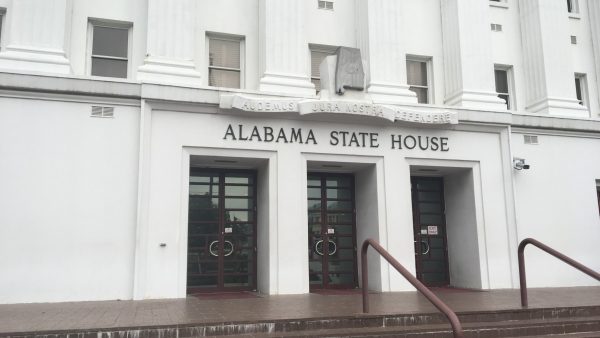Tranquil Resource, Contentious Beginnings
About seven miles from Fort Payne is the northern gateway to a vision, a vision of a nearly hundred-mile “central park” between Birmingham, Atlanta and Chattanooga. Decades in the making, the conservation, tourism, and education opportunities are gelling in this huge green corridor. In Part Two of his series, WBHM’s Southern Education Desk reporter Dan Carsen has the intriguing story behind this growing resource:
A lot of people from Alabama, or fans of the group Alabama, know that country superstar Randy Owen once sang an anthem to his beloved Little River Canyon, which was a big part of his upbringing. A short walk away from the canyon is the Little River Canyon Center, a gleaming high-tech “green building” that’s becoming a campus, museum, community center, and tourist attraction. But a long walk, or a scenic drive, is what’ll begin to show you the scale of what’s happened here in the last few decades. If you’re in the Little River Canyon National Preserve anywhere near the “big falls” of the sometimes inaptly named Little River, you’ll hear them. It’s easy to tell why only the most daring kayakers even think about descending them, and why the Alabama Power Company considered trying to harness the energy in all that moving water. From 1912 to the early 90s, the company owned most of the land around the river. But generating power here was problematic.

As longtime resident and community leader Ricky Harcrow remembers, “It was a nightmare to dam it up the way that thing is, because of the gorge.”
In 1992, Congressman Tom Bevill called power company president and CEO Elmer Harris and asked the company to donate land for a national preserve. Harris Balked at a straight donation but agreed to give away some of the land and sell the rest for tax breaks and almost eight million earmarked federal dollars, which went into the company’s charity foundation.
Sound like a 14,000-acre win-win for all? Not so fast:
Says Harcrow, “There was a lot of opposition because of old landowners here. And a lot of ’em didn’t live here. It was kind of a retreat for ’em. [And people were concerned with] intervention by the government, taking over this that and the other.”
Even though the power company owned the land, people were fiercely attached to it, partly because the company allowed them to hunt on it. Pete Conroy, one of the Preserve plan’s main movers, says landowners and property rights groups from Washington got involved, too:
“The opposition really came from local folks who had been coerced by outsiders to distrust the process. I met really terrific people who had actually been told, ‘Yup, they’re gonna shoot your dog and burn your barn.'”
Lucky for the project, a “dream team” of Alabama Power, state government, allies in Congress, and local-boy-superstar Randy Owen saw the opportunity of what could be done and very publicly got behind it.
Conroy calls it a “partnership project,” adding, “A lot of us just spent a lot of time drinking coffee with folks, and gaining trust, and slowly but surely telling the story of what we thought would happen, and I think we really hit the right balance. There was not an inch of property taken by the government — no eminent domain, no condemnation. And I think that the National Park Service has really turned out to be a pretty good friend of the region.”

In October 1992, the Little River Canyon National Preserve became latest addition to the National Park System. People in the community — not to mention tourists I met from New York and Michigan — say the preserve and the Canyon Center are educational and economic boons to the area that enhance quality of life.
As people learn about the Preserve and the Center, all different kinds are taking advantage of the education and recreation programs, from class trips to Hindu weddings to rock-climbing to holiday programs held in Spanish.
“Next thing you know,” says Conroy, “there’s a nice family from Fort Payne that have always been here, hanging out with a nice family from Mexico City. Next thing you know, they’re having dinner together, and the next thing you know, their kids — ‘Oh, yeah, they go to the same school’ — and, it’s this community of people coming together to learn and be educated together.”

The larger plan for a green corridor from Little River Canyon in the North, down through protected areas to the Cheaha Wilderness in the south, is coming together. But thanks to decades of tenacity and good-old-fashioned people skills, there’s plenty for students, teachers, outdoors-people, and just regular folks to experience right now.
Florida’s 6-week abortion ban will have a ‘snowball effect’ on residents across the South
Abortion rights advocates say the ban will likely force many to travel farther for abortion care and endure pregnancy and childbirth against their will.
Attitudes among Alabama lawmakers softening on Medicaid expansion
Alabama is one of ten states which has not expanded Medicaid. Republican leaders have pushed back against the idea for years.
Birmingham is 3rd worst in the Southeast for ozone pollution, new report says
The American Lung Association's "State of the Air" report shows some metro areas in the Gulf States continue to have poor air quality.
Why haven’t Kansas and Alabama — among other holdouts — expanded access to Medicaid?
Only 10 states have not joined the federal program that expands Medicaid to people who are still in the "coverage gap" for health care
Once praised, settlement to help sickened BP oil spill workers leaves most with nearly nothing
Thousands of ordinary people who helped clean up after the 2010 BP oil spill in the Gulf of Mexico say they got sick. A court settlement was supposed to help compensate them, but it hasn’t turned out as expected.
Q&A: How harm reduction can help mitigate the opioid crisis
Maia Szalavitz discusses harm reduction's effectiveness against drug addiction, how punitive policies can hurt people who need pain medication and more.







